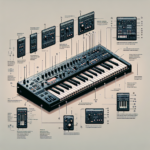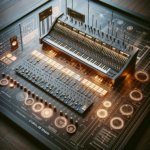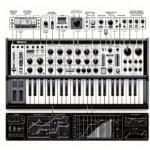Alesis Q88: Comprehensive Guide to Features, Setup, and Performance

Introduction
The Alesis Q88 is a versatile MIDI controller designed to meet the needs of both beginner and professional musicians. With its 88 full-sized, semi-weighted keys, the Q88 offers a realistic piano feel, making it an excellent choice for those who require a high-quality keyboard for studio production, live performances, or educational purposes. Targeted at a wide range of users, from aspiring musicians to seasoned professionals, the Alesis Q88 aims to provide a comprehensive solution for all your MIDI control needs.
Alesis, a well-known brand in the music industry, has built a reputation for producing reliable and innovative musical instruments and equipment. With decades of experience, Alesis continues to be a trusted name among musicians and producers worldwide.
Key Features Overview:
- 88 full-sized, semi-weighted keys
- USB-MIDI and traditional MIDI Out
- Pitch bend and modulation wheels
- Assignable data slider
- Compatible with most DAWs and music software
- Lightweight and portable design
Design and Build Quality
Physical Design
The Alesis Q88 features a sleek and minimalist design, with dimensions of approximately 54.8 inches in length, 9.5 inches in width, and 4 inches in height. Weighing around 17 pounds, the Q88 is relatively lightweight for an 88-key controller, making it easier to transport. The keys are full-sized and semi-weighted, providing a realistic piano feel that is suitable for both practice and performance. The controller is constructed from durable plastic, with a matte finish that resists fingerprints and smudges.
Portability
Despite its full-sized keyboard, the Alesis Q88 is designed with portability in mind. Its lightweight construction and slim profile make it easy to transport to gigs, rehearsals, or studio sessions. The controller can be easily packed into a keyboard bag or case, ensuring that it remains protected during transit.
Durability
The build quality of the Alesis Q88 is robust, with a solid construction that can withstand regular use. The keys are responsive and durable, capable of handling the demands of both practice and performance. The pitch bend and modulation wheels, as well as the assignable data slider, are also well-built and designed to last.
Setup and Configuration
Initial Setup
Setting up the Alesis Q88 is a straightforward process. Follow these steps to get started:
- Unbox the controller and place it on a stable surface.
- Connect the Q88 to your computer using the included USB cable.
- Power on the controller by connecting it to a power source if required (some setups may not need an external power source).
- Ensure that your computer recognizes the controller by checking the device manager or system preferences.
Software Installation
The Alesis Q88 is class-compliant, meaning it does not require any additional drivers for most operating systems. However, you may need to install specific software or drivers for certain DAWs or advanced features. Follow these steps:
- Visit the Alesis website and navigate to the Q88 product page.
- Download any available drivers or software updates.
- Install the downloaded software by following the on-screen instructions.
- Restart your computer if prompted.
Compatibility
The Alesis Q88 is compatible with a wide range of operating systems and DAWs. Compatible operating systems include:
- Windows 7, 8, 10, and later
- macOS 10.7 and later
Compatible DAWs and software include:
- Ableton Live
- FL Studio
- Logic Pro
- Pro Tools
- GarageBand
- Cubase
Features and Functionality
Key Features
The Alesis Q88 offers a range of features designed to enhance your music production and performance experience:
- 88 Full-Sized, Semi-Weighted Keys: Provides a realistic piano feel, suitable for both practice and performance.
- Pitch Bend and Modulation Wheels: Allows for expressive control over your sound.
- Assignable Data Slider: Can be used to control various parameters within your DAW or software.
- USB-MIDI and Traditional MIDI Out: Ensures compatibility with a wide range of devices and software.
Customizability
The Alesis Q88 offers a high degree of customizability, allowing users to tailor the controller to their specific needs. MIDI mapping can be easily configured within your DAW, enabling you to assign functions to the keys, wheels, and slider. This flexibility makes the Q88 suitable for a wide range of musical styles and workflows.
Unique Functions
One of the standout features of the Alesis Q88 is its simplicity and ease of use. While it may not have as many bells and whistles as some other controllers, its straightforward design and functionality make it an excellent choice for those who prefer a no-nonsense approach to music production and performance.
Integration with DAWs
The Alesis Q88 integrates seamlessly with most popular DAWs, including Ableton Live, FL Studio, Logic Pro, and more. The controller is recognized automatically by most software, allowing you to start making music right away. The assignable data slider and pitch bend/modulation wheels can be mapped to various parameters within your DAW, providing additional control over your sound.
Advanced Features
While the Alesis Q88 is primarily designed for straightforward MIDI control, it does offer some advanced features that can enhance your music production experience. These include:
- Aftertouch: Provides additional expressive control by responding to the pressure applied to the keys after they are initially pressed.
- Arpeggiators: Some DAWs and software can utilize the Q88’s keys to trigger arpeggiator functions, creating complex rhythmic patterns.
- Chord Modes: Allows for the easy creation of chords by pressing a single key, useful for live performance and composition.
Performance
Latency and Responsiveness
The Alesis Q88 performs exceptionally well in terms of latency and responsiveness. The keys are responsive and provide a realistic feel, making it easy to play complex passages with precision. The pitch bend and modulation wheels are also highly responsive, allowing for expressive control over your sound.
Real-World Usage
In practical scenarios, the Alesis Q88 excels as both a studio and live performance tool. Its full-sized, semi-weighted keys make it an excellent choice for piano players, while its lightweight design ensures that it can be easily transported to gigs and rehearsals. The controller’s straightforward functionality and seamless integration with most DAWs make it a reliable choice for music production and recording.
User Experience
User feedback for the Alesis Q88 is generally positive, with many praising its realistic key feel, ease of use, and portability. Some users have noted that the controller’s simplicity is one of its greatest strengths, as it allows them to focus on making music without being bogged down by unnecessary features.
Applications and Use Cases
Beginner vs. Professional Use
The Alesis Q88 is suitable for both beginners and professionals. Its straightforward design and ease of use make it an excellent choice for those who are new to MIDI controllers, while its high-quality keys and advanced features ensure that it can meet the needs of more experienced musicians.
Studio Use
In a studio environment, the Alesis Q88 is a versatile tool for music production and recording. Its full-sized keys provide a realistic piano feel, making it an excellent choice for composing and performing piano parts. The controller’s seamless integration with most DAWs ensures that it can be easily incorporated into your existing workflow.
Live Performance
The Alesis Q88 is also well-suited for live performance. Its lightweight design makes it easy to transport to gigs, while its responsive keys and expressive controls ensure that you can deliver a high-quality performance. The controller’s straightforward functionality makes it easy to set up and use on stage, allowing you to focus on your performance.
Specific Genres
The Alesis Q88 excels in a wide range of musical genres, including:
- EDM: The controller’s responsive keys and expressive controls make it an excellent choice for electronic dance music production and performance.
- Hip-Hop: The Q88’s full-sized keys and assignable data slider provide the control needed for creating complex beats and melodies.
- Classical: The realistic piano feel of the Q88’s keys makes it an excellent choice for classical musicians and composers.
Pros and Cons
Pros:
- 88 full-sized, semi-weighted keys provide a realistic piano feel
- Lightweight and portable design
- Seamless integration with most DAWs
- Responsive pitch bend and modulation wheels
- Assignable data slider for additional control
- Compatible with a wide range of operating systems and software
Cons:
- Lacks some advanced features found in more expensive controllers
- Plastic construction may not be as durable as metal alternatives
- No built-in display for visual feedback
Common Issues and Troubleshooting
Known Issues
Some users have reported occasional connectivity issues with the Alesis Q88, particularly when using older operating systems or DAWs. Additionally, the lack of a built-in display can make it difficult to monitor certain parameters during use.
Troubleshooting Tips
If you encounter issues with the Alesis Q88, try the following troubleshooting tips:
- Ensure that your operating system and DAW are up to date.
- Check all connections and cables to ensure they are secure.
- Restart your computer and the controller.
- Consult the Alesis website for any available software updates or drivers.
Customer Support
Alesis offers comprehensive customer support for the Q88, including online resources, user manuals, and a dedicated support team. Users can contact Alesis support via email or phone for assistance with any issues or questions they may have.
Comparisons with Similar Controllers
Competitor Comparison
When compared to similar models from other brands, the Alesis Q88 stands out for its combination of affordability, portability, and realistic key feel. Competitors such as the M-Audio Keystation 88 and the Novation Launchkey 88 offer similar features, but the Q88’s lightweight design and straightforward functionality make it a popular choice among musicians.
Feature Comparison
While the Alesis Q88 may lack some of the advanced features found in more expensive controllers, such as built-in displays or extensive control options, it excels in providing a high-quality playing experience at an affordable price. The Q88’s full-sized, semi-weighted keys and responsive controls make it a reliable choice for both studio and live performance.
Conclusion
Summary
The Alesis Q88 is a versatile and reliable MIDI controller that offers a realistic playing experience at an affordable price. With its full-sized, semi-weighted keys, lightweight design, and seamless integration with most DAWs, the Q88 is an excellent choice for both beginners and professionals.
Who Should Buy This?
The Alesis Q88 is best suited for musicians who require a high-quality keyboard for studio production, live performances, or educational purposes. Its straightforward design and ease of use make it an excellent choice for beginners, while its realistic key feel and advanced features ensure that it can meet the needs of more experienced musicians.
Final Thoughts
Overall, the Alesis Q88 is a well-rounded MIDI controller that offers a great balance of features, performance, and affordability. Whether you’re a beginner looking for your first MIDI controller or a professional in need of a reliable tool for your studio or live setup, the Alesis Q88 is a solid choice that won’t disappoint.
FAQ
Is the Alesis Q88 compatible with my DAW?
The Alesis Q88 is compatible with most popular DAWs, including Ableton Live, FL Studio, Logic Pro, Pro Tools, GarageBand, and Cubase.
Do I need to install any drivers to use the Alesis Q88?
The Alesis Q88 is class-compliant and does not require any additional drivers for most operating systems. However, you may need to install specific software or drivers for certain DAWs or advanced features.
Can I use the Alesis Q88 with my iPad or other mobile devices?
Yes, the Alesis Q88 can be used with iPads and other mobile devices that support USB-MIDI connections. You may need an appropriate adapter to connect the controller to your device.
Does the Alesis Q88 have built-in sounds?
No, the Alesis Q88 is a MIDI controller and does not have built-in sounds. It is designed to control software instruments and external hardware via MIDI.
How do I assign functions to the data slider and wheels?
You can assign functions to the data slider and wheels within your DAW’s MIDI mapping settings. Consult your DAW’s user manual for specific instructions on how to configure MIDI mappings.
Where to Buy
The Alesis Q88 can be purchased from a variety of retailers, including major music stores such as Guitar Center, Sweetwater, and Sam Ash. It is also available from online marketplaces like Amazon and eBay. Be sure to check for any available promotions or discounts to get the best deal on your purchase.




